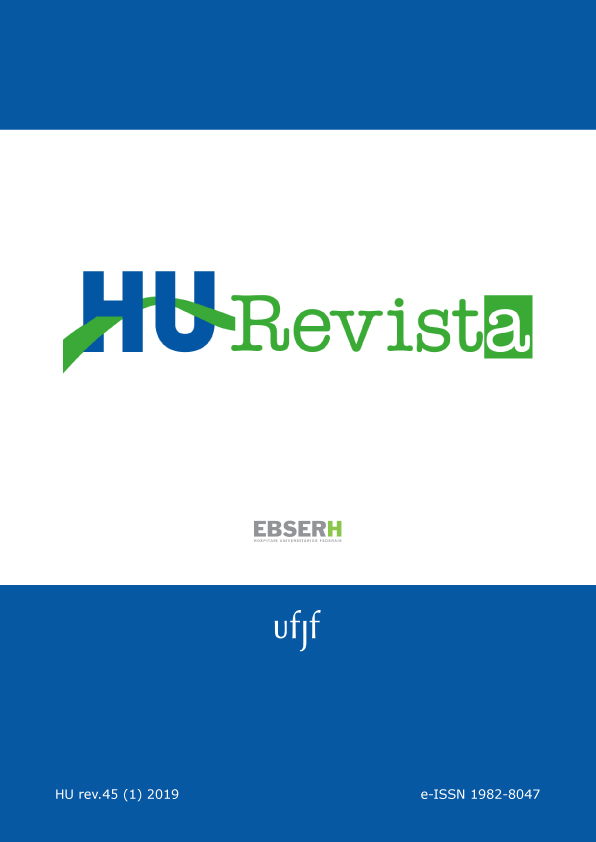Morphometric analysis of maxilla applied to Le Fort I osteotomy
DOI:
https://doi.org/10.34019/1982-8047.2019.v45.13888Keywords:
Maxilla, Orthognathic Surgery, OsteotomyAbstract
Introduction: The Le Fort I osteotomy is a surgical technique used for correction of dentofacial deformities and dislocation of the pterygomaxillary suture for mobilization of maxilla. During this procedure, complications may happen, such as hemorrhage resulting from the injury of the internal maxillary artery or its terminal branches, in which the descending palatine artery is more common to be injured. Objective: The aim of this study was to contribute for establishment of safe surgical parameters to improve osteotomy with pterygomaxillary disjunction, through the measurement of the maxillary and pterygomaxillary regions. Material and Method: Forty dry skulls (male and female) of the Department of Anatomy of a public institution were selected and the measurements were made by the direct inspection method using a Mitutoyo® digital caliper and a Staedtler compass ®. The height and thickness of the pterygomaxillary junction, the distance from the pterygomaxillary suture to the zygomatic pillar, the distance from the lower point of the pterygomaxillary suture to the inferior orbital fissure, the extension of the lateral wall of the nasal cavity to the descending palatine canal, and the length of the nasal septum, bilaterally, were measured. For the statistical analysis of the results, the t-test was used for independent samples, with a significance level of 5%. Results: We found that on the right side, the averages of the respective measurements were 14.88mm, 9.17mm, 27.60mm, 34.47mm and 36.86; and on the left side, the averages were, respectively, 15.18mm, 9.08mm, 26.50mm, 34.70mm and 36.02mm. The mean value of nasal septum length was 49.10 mm. Conclusion: Based on the values obtained it is possible to establish operative parameters for the Le Fort I osteotomy.
Downloads
References
Ho MW, Boyle MA, Cooper JC, Dodd MD, Richardson D. Surgical complications of segmental Le Fort I osteotomy. British Journal of Oral and Maxillofacial Surgery. 2011; 49:562–566.
Leite Segundo AV, Bozzetto-Ambrosi P, Cauas M, Caubi AF, Azevedo Filho HRC. Utilização da osteotomia Le Fort I na abordagem cirúrgica de carcinoma epidermóide de base de crânio. Revista de Cirurgia e Traumatologia Buco-maxilo-facial. 2007; 7(2):55-60.
Li KK, Meara JG, Jr AA. Location of the descending palatine artery in relation to the Le Fort I osteotomy. J Oral Maxillofac Surg. 1996; 54:822-825.
Cheung LK, Fung SC, Li T, Samman N. Posterior maxillary anatomy: implications for Le Fort I osteotomy. Int J Oral Maxillofac Surg. 1998; 27:346-351.
O’ Regan B, Bharadwaj G. Prospective study of the incidence of serious posterior maxillary haemorrhage during a tuberosity osteotomy in low level Le Fort I operations. British Journal of Oral and Maxillofacial Surgery. 2007; 45:538–542.
Ueki K, Hashiba Y, Marukawa K, Okabe K, Alam S, Nakagawa K, et al. Assessment of pterygomaxillary separation in Le Fort I osteotomy in class III patients. J Oral Maxillofac Surg. 2009; 67:833-839.
Ferraz FWS, Brinhole MCP, Elias FM. Avaliação morfométrica da parede nasal lateral e da região maxilar posterior. Implicações na osteotomia tipo Le Fort I. Revista Brasileira de Cirurgia Buco-maxilo-facial. 2011; 11(2):7-14.
Lanigan DT, Guest P. Alternative approaches to pterygomaxillary separation. Int J Oral Maxillofac Surg. 1993; 22:131-138.
Kim JW, Chin BR, Park HS, Lee SH, Kwon TG. Cranial nerve injury after Le Fort I osteotomy. Int J Oral Maxillofac Surg. 2011; 40: 327–329.
Laster Z, Ardekian L, Rachmiel A, Peled M. Use of the ‘shark-fin’ osteotome in separation of the pterygomaxillary junction in Le Fort I osteotomy: a clinical and computerized tomography study. Int J Oral Maxillofac Surg. 2002; 31(1):100-3.
Lanigan DT, Hey JH, West R. A. Aseptic necrosis following maxillary osteotomies: report of 36 cases. Int J Oral Maxillofac Surg. 1990; 48: 142-56.
Dodson TB, Bays RA, Neuenschwander MC. Maxillary perfusion during Le Fort I osteotomy after ligation of the descending palatine artery. J Oral Maxillofac Surg. 1997; 55:51-55.
Robinson PP, Hendy CW. Pterygoid plate fractures caused by the le fort I osteotomy. British Journal of Oral and Maxillofacial Surgery. 1986; 24:198-202.
Dolanmaz D, Esen A, Emlik D, Çandirli C, Kalayci A, Cicekcibasi A. Comparison of two different approches to the pterygomaxillary junction in Le Fort I osteotomy. Oral Surg Oral Med Oral Pathol Oral Radiol. 2008; 106 (3):e1-5.
Kanazawa T, Kuroyanagi N, Miyachi H, Ochiai S, Kamiya N, Nagao T, et al. Factors predictive of pterygoid process fractures after pterygomaxillary separation without using an osteotome in Le Fort I osteotomy. Oral Surg Oral Med Oral Pathol Oral Radiol. 2013; 115:310-318.
Stajcic Z. Altering the angulation of a curved osteotome – Does it have effects on the type of pterygomaxillary disjunction in Le Fort I osteotomy? An experimental study. Int J Oral Maxillofac Surg. 1991; 20:301-303.
O’ Regan B.; Bharadwaj G. Pterygomaxillary separation in Le Fort I osteotomy UK OMFS consultant questionnaire survey. British Journal of Oral and Maxillofacial Surgery. 2006; 44:20–23.
Trimble LD, Tideman H; Stoelinga PJW. A modification of the pterygoid plate separation in low-level maxillary osteotomies. Journal of Cranio-Maxillofacial Surgery. 1983; 41: 544-546.
Wikkeling OM, Tacoma J. Osteotomy of the pteryygomaxillary junction. J Oral Maxillofac Surg. 1975; 4 (3):99-103.
Ueki K, Nakagawa K, Marukawa K, Yamamoto E. Le Fort I osteotomy using an ultrasonic bone curette to fracture the pterygoid plates. J Craniomaxillofac Surg. 2004; 32(6):381-6.
Gomes-Filho JCO. Delimitação morfométrica da sutura pterigomaxilar em crânios secos com maxilas atróficas e considerações sobre a técnica da sua disjunção com cinzel curvo. Revista de Odontologia (São Paulo. Online). 2011; VII:516-34.
Alves N. Estudio anatómico de la región pterigopalatina en cráneos macerados de brasileños con el objetivo de contribuir al desarrollo de la técnica de disyunción de la sutura esfenomaxilar. Int J Morphol. 2013; 31(2):480-484.
Downloads
Published
How to Cite
Issue
Section
License
Cessão de Primeira Publicação à HU Revista
Os autores mantém todos os direitos autorais sobre a publicação, sem restrições, e concedem à HU Revista o direito de primeira publicação, com o trabalho licenciado sob a Licença Creative Commons Attribution que permite o compartilhamento irrestrito do trabalho, com reconhecimento da autoria e crédito pela citação de publicação inicial nesta revista, referenciando inclusive seu DOI.









